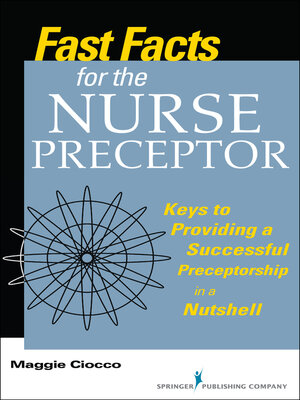Fast Facts for the Nurse Preceptor
ebook ∣ Keys to Providing a Successful Preceptorship in a Nutshell · Fast Facts
By Maggie Ciocco

Sign up to save your library
With an OverDrive account, you can save your favorite libraries for at-a-glance information about availability. Find out more about OverDrive accounts.
Find this title in Libby, the library reading app by OverDrive.



Search for a digital library with this title
Title found at these libraries:
| Library Name | Distance |
|---|---|
| Loading... |
Dedicated and competent nurse preceptors are vital to the success of health care organizations and to the retention of nurses in the profession. Yet clinical teaching and supervision is a skill that must be developed; a knowledgeable and experienced practitioner does not automatically become a successful nurse preceptor. This pithy reference guide for nurses in the preceptor role is brimming with information about how to successfully educate, protect, socialize, and evaluate nurses transitioning into a new environment. In an easy-access, bulleted format, this resource helps preceptors to establish clinical objectives, execute evaluation and feedback techniques, identify role responsibilities, develop positive communication skills, and develop effective teaching/learning strategies.
The guide addresses the qualities of a good preceptor, communication and delegation skills, and the importance of evidence-based practice for the preceptor role. It discusses how to prepare new nurses for the reality shock of entering a new arena, and how to recognize and help the preceptee who is struggling. Nurse preceptors will gain insight into how to assist preceptees in organizing their clinical day and prioritizing their responsibilities. From suggestions in conflict resolution and bullying to aids in developing critical thinking skills to advice on completing relevant documentation, this guide helps new nurse preceptors to provide a well-orchestrated orientation that will ensure a positive experience for novice nurses and the subsequent delivery of quality, patient-centered care. Sample competency forms and clinical tools add to the bookís utility, as well.
Key Features:
Delivers vital information on all aspects of successful nurse preceptorship in a concise, easy-access format
Includes evidence-based content throughout
Provides guidance on identifying and developing successful nurse preceptors
Addresses organization, prioritization, delegation, effective communication, conflict resolution, and the development of critical thinking skills
Offers key information on competency assessment and evaluations
A special ìPreceptorís Problem Solverî chapter addresses clinical issues unique to the nurse preceptorís role







